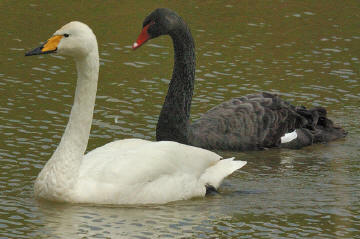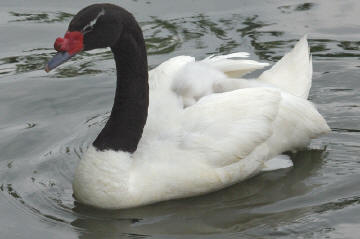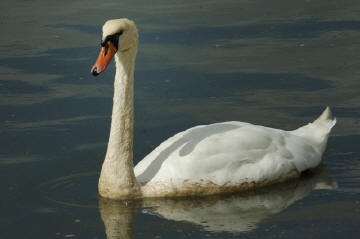Article
Swans
Swans are a very large heavy
water bird and are closely related to geese and ducks. The are 7 species of Swan
worldwide, those from the Northern hemisphere typically have white plumage,
whereas those from the Southern hemisphere are mixed black and white.
|
Swan breeds include:
-
Mute
Swan
 - native to Britain - native to Britain
-
Whooper Swan
 - migrates to the UK during winter months from their arctic
breeding grounds - migrates to the UK during winter months from their arctic
breeding grounds
-
Bewick's Swan
 - migrates to the UK during winter months from their arctic
breeding grounds - migrates to the UK during winter months from their arctic
breeding grounds
-
Trumpeter Swan
-
Whistling Swan
-
Black Swan - a breed of
Australia and introduced into New Zealand
-
Black Necked Swan - from
South America
|


|
The
Mute
Swan
 is native to
Britain and is here all year round, other breeds you will find in the wild
within the UK during the winter months are the
Whooper Swan is native to
Britain and is here all year round, other breeds you will find in the wild
within the UK during the winter months are the
Whooper Swan
 and
the
Bewick's Swan. and
the
Bewick's Swan.
 The
other breads listed you will come across in some of the Wetland centres and other
wildlife collections within the UK. For instance I have seen the Black Swan in
the Wildfowl and Wetland Centre in
Slimbridge Gloucestershire The
other breads listed you will come across in some of the Wetland centres and other
wildlife collections within the UK. For instance I have seen the Black Swan in
the Wildfowl and Wetland Centre in
Slimbridge Gloucestershire
 and the Black
Necked Swan at
Martin Mere and the Black
Necked Swan at
Martin Mere
 in Lancashire. in Lancashire.
Characteristics
|
They
are very long-necked birds and telling the difference between the sexes on
initial site is difficult as they look very similar. Out of water they have a
waddling walk, however in water they are majestic. When they feed they up-end to
browse on the bottom for their food.
A male swan is called a Cob
and can weigh up to 15kg and have a wing span of 2.3m, the female is a Pen and
is smaller, their offspring are called Cygnets. The life expectancy of a swan is
around 10-12 years, although some mating pairs have been recorded as living for
around 20 years. They can start breeding at 3-4 years of age and typically
during their teenage years will live in flocks.
|
  |
They usually mate for life
although they have been known to "divorce" particularly following a nesting
failure. Swans lay eggs and can have a clutch size of between 3 and 8. A female
Mute Swan will typically have a clutch of 6 and takes 25 days to incubate and
are usually born around May, and can usually fly at 4-5 months, around September
time. They are devoted parents keeping a watchful eye on them at all times and
allowing them to 'hitch a lift' on their backs as well as teaching them how to
feed on the underwater plants which forms a major part of their diet.
|
Swan Upping
Within
the UK there is an ancient ceremony associated with swans called 'Swan Upping',
this dates back to the 12th century when in England ownership of all Mutes Swans
was declared by the monarchy and it was a dish at banquets and feasts.
Click Here
 for more details. for more details.
Popular Culture
Swans feature quite a lot
in popular culture and the most well known of these is 'The Ugly Duckling'
fable, which is centred around a duckling who is mistreated until it becomes
clear that in fact he is a swan and not a duck after all. Others include:
|
  |
-
Swans are often used as a symbol of love and
fidelity because of their long lasting monogamous relationships.
-
Swan Maidens who are able to transform from
human to swan and vice versa are a worldwide motif in folklore, a typical tale
is of a swan who is temporarily robbed of her powers and forced to marry a
human man.
-
The phrase swan song is believed to come
from the myth that upon the death of an otherwise silent Mute Swan it would
sing beautifully.
-
The Black Swan is the faunal emblem of
Western Australia and features on the coat of arms of Canberra the Australian
capital.
-
They feature in both Greek and Norse
mythology.
-
The Irish Legend of Children of Lir is about
a stepmother who transformed her children into swans for 900 years.
-
Swan Lake the Ballet by Tchaikovsky in 1875
represents the story of swan-maidens, which has a history back in Greek
mythology.
The Bishops Palace, at Wells Cathedral, Wells
in Somerset has Mute Swans within its moat. For centuries they were
trained to ring bells via strings attached to them to ask for food. In fact it
is said two swans still do. Take a look at their
Swan
Watch
 to keep
up to date with what the Swans are getting up to. to keep
up to date with what the Swans are getting up to.
Locations for catching a glimpse of Swans in the UK
Throughout the UK our native
Mute Swans  can be found on many of our rivers,
gravel pits, canals and open water spaces. There are also various other
locations including a Swannery and Swan and Rescue Sanctuaries where you can get
to see them close up.
can be found on many of our rivers,
gravel pits, canals and open water spaces. There are also various other
locations including a Swannery and Swan and Rescue Sanctuaries where you can get
to see them close up.
Over the
years the town of Berwick-upon-Tweed has become home to the second largest
mute swan colony in Britain. The swans are now such a familiar feature of
the Tweed estuary that they have become a well-known tourist attraction, and
at peak times almost 800 birds have been counted on the river. There are
around 200 permanent residents (mainly non-breeding adults and juvenile
birds) but the numbers increase in late summer and through the winter as
swans from other areas arrive to undergo the annual moult or to take
advantage of the rich feeding at the Tweed estuary.
Take a
look at our
Where to Photograph Swans
 list page for
a list of places where you can see and photograph Swans. list page for
a list of places where you can see and photograph Swans.
See
Also:
Swans 
Where to Photograph Swans (Location List)

Mute Swan 
Bewick's Swan

Whooper Swan

Swan Upping
 - the ancient annual census of Mute Swans on the River Thames
- the ancient annual census of Mute Swans on the River Thames
|